Aluminum Thickness Tests
Revision as of 21:01, 17 October 2017 by Harpconn (talk | contribs) (→Where are photons below 300 keV from?)
No Photon Physics
- Varying Aluminum beamstop thickness
- Tantalum thickness of 0.0508cm
- All electron physics turned on
- No photon physics turned on
- Chamber and Tracker matter is vacuum
- 1 Radiation Length of Aluminum is 8.897cm
| Aluminum Thickness | Photon Kinetic Energy Spectrum | Z Position of Photon Creation | Volume of Photon Creation |
| 8.897cm | 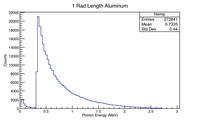 |
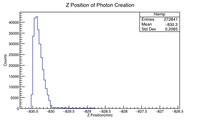 |
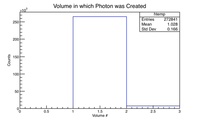
|
| 4.4485cm | 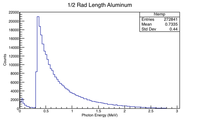 |
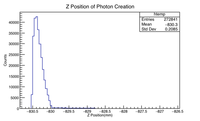 |
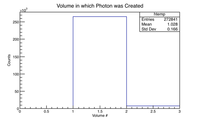
|
| 2.22425cm | 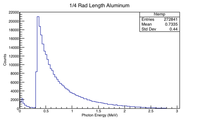 |
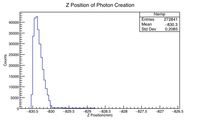 |
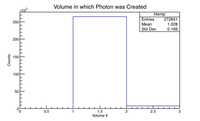
|
| 1.5875cm (5/8") | 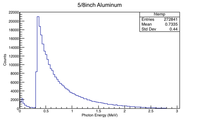 |
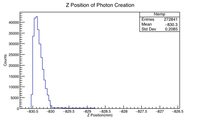 |
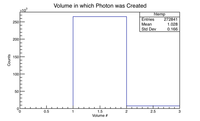
|
| 1.27cm (1/2") | 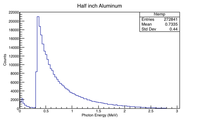 |
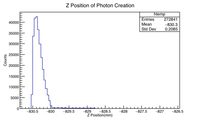 |
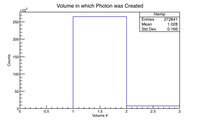
|
Note: Volume 1 = Target, Volume 2 = Beamstop, Volume 3 = Tracker, Volume 4 = Chamber, Volume 5 = else
Conclusion
Without photon physics active and vacuum in the tracker and chamber, I cannot say whether electrons are making it though the target and beamstop.
Where are photons below 300 keV from?
| Physics | Photon Kinetic Energy Spectrum (Vacuum) | Photon Kinetic Energy Spectrum (Air) |
| Photon Physics Off | 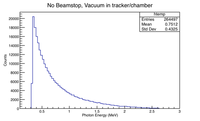 |
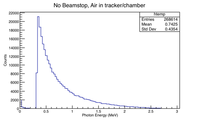
|
| Photon Physics On | 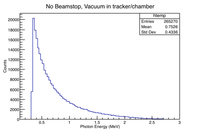 |
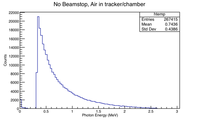
|
- As seen in the first image, if I remove the Aluminum beamstop, the <300KeV photon peak disappears. This leads me to believe that the it was electrons/photons interacting in the aluminum to create the lower energy photons.
- In the second image, the low energy peak reappears, but is not the same as with the earlier simulations when the beamstop was aluminum. Looking at the volume in which photons were created, I can see that there are some interactions in the air. This could be pair production or electrons interacting directly with the air. These photons were not present in the simulation without air.
Photon Physics On
- Varying Aluminum beamstop thickness
- Tantalum thickness of 0.0508cm
- All electron physics turned on
- All photon physics turned on
- Chamber and Tracker matter is vacuum
- 1 Radiation Length of Aluminum is 8.897cm
| Aluminum Thickness | Photon Kinetic Energy Spectrum | Z Position of Photon Creation | Volume of Photon Creation |
| 8.897cm | 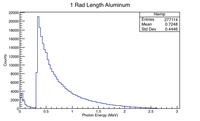 |
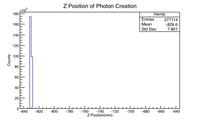 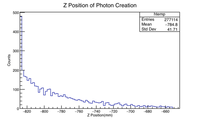 |
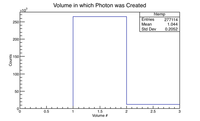
|
| 1.5875cm (5/8") | 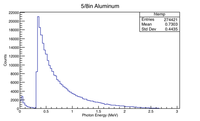 |
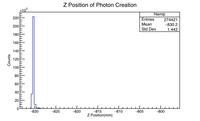 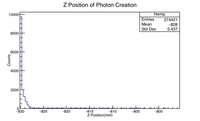 |
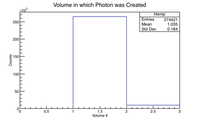
|
| 1.27cm (1/2") | 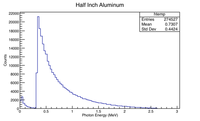 |
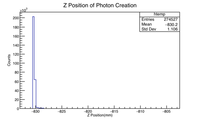 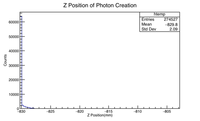 |
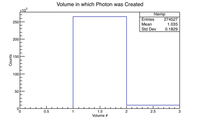
|
| 4.4485cm | 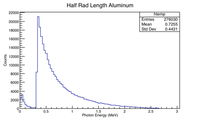 |
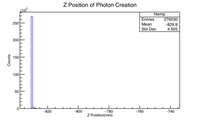 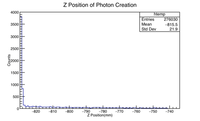 |
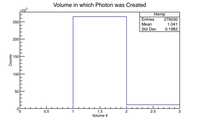
|
| 2.22425cm | 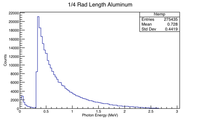 |
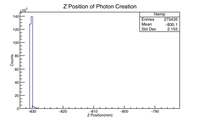 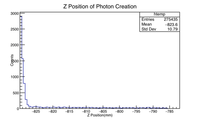 |
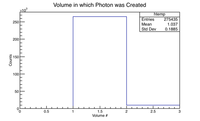
|
Note: Volume 1 = Target, Volume 2 = Beamstop, Volume 3 = Tracker, Volume 4 = Chamber, Volume 5 = else
Conclusion
Why is tail 16 cm long?
I am going to rerun the 1 rad length simulation to see if i get the same result which will help me determine if i had an error in which matter i used in tracker/chamber, etc.
Photon Physics On with Air in Chamber and Tracker
- Varying Aluminum beamstop thickness
- Tantalum thickness of 0.0508cm
- All electron physics turned on
- All photon physics turned on
- Chamber and Tracker matter is air (70% Nitrogen, 30% Oxygen)
- 1 Radiation Length of Aluminum is 8.897cm
| Aluminum Thickness | Photon Kinetic Energy Spectrum | Z Position of Photon Creation | Volume of Photon Creation |
| 8.897cm | 200px | 200px | 200px |
| 1.5875cm (5/8") | 200px | 200px | 200px |
| 1.27cm (1/2") | 200px | 200px | 200px |
| 4.4485cm | 200px | 200px | 200px |
| 2.22425cm | 200px | 200px | 200px |
- Note: Volume 1 = Target, Volume 2 = Beamstop, Volume 3 = Tracker, Volume 4 = Chamber, Volume 5 = else